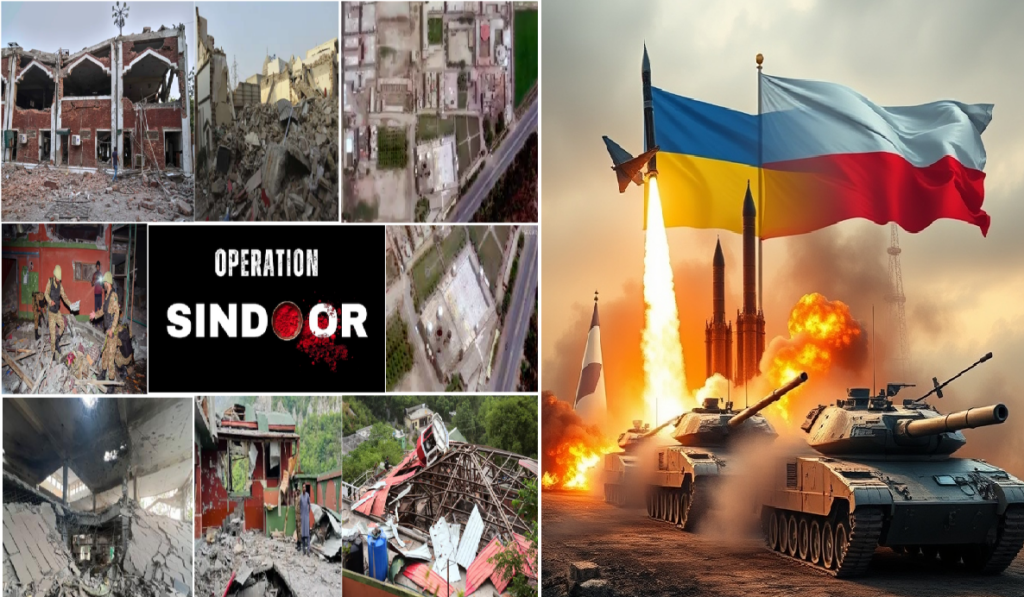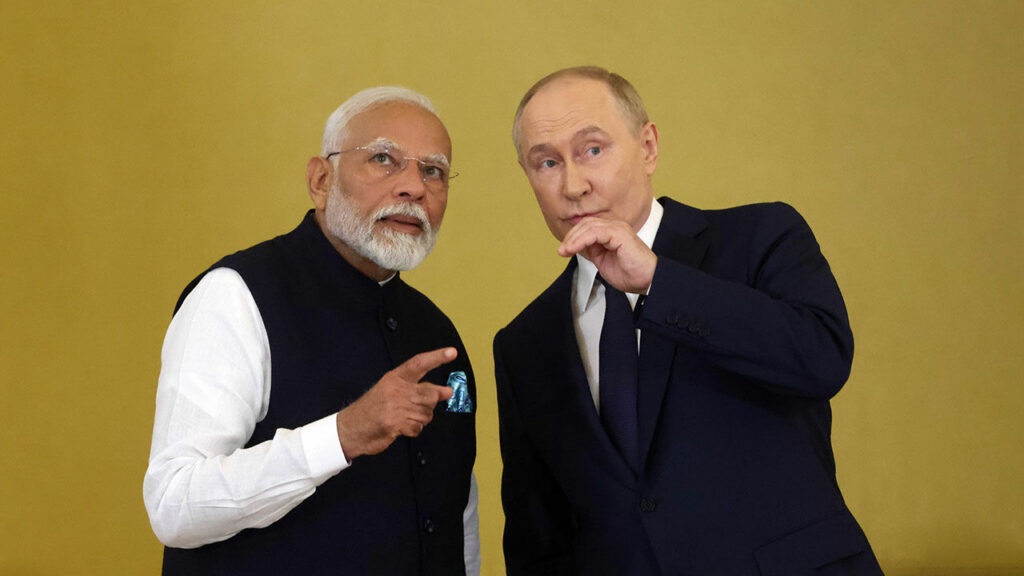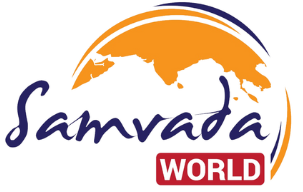
- Both Pakistan and Ukraine were born out of India & USSR, respectively, and the complex relationships that the split brought about.
- Societies of both Ukraine & Pakistan have been indoctrinated through powerful narratives to hate Russia & India, respectively.
- From 2014, the US and its allies in Western Europe have armed and trained the Ukrainian army against Russia.
- While Russia has opted for a pragmatic and real-world political approach to weed out the root cause, India’s approach is more idealistic and transactional.
India and Russia have, over the last 75 years, established a robust partnership that has benefited both countries. Russia sending its submarine fleet to counter the US 7th fleet and India buying Russian oil despite Western pressure are instances that come readily to mind. Both Russia and India face challenges on their western borders. This article analyses the issues faced and the surprising parallels that emerge. Even more interesting is the diametrically opposite approaches adopted by them to tackle the issue. The first part of the article reflects the parallels, while in part two, an analysis of the contrasting approach is presented.
Strategic Parallels: Geopolitical Legacies, Hostile Neighbours, and the West
Victims of Geography. Both Pakistan and Ukraine were born out of India & USSR, respectively and the complex relationships that the split brought about. The issues that confront both countries stem from a geographical reality that haunts the leaders and citizens of both countries. For centuries, both Russia & India have been attacked from the west. Russia was attacked by the Poles in 1605, followed by the Swedes under Charles XII in 1707, the French under Napoleon in 1812, and the Germans twice, in both world wars, in 1914 and 1941. India has been the target of attacks by Islamic hordes from the west since 712 AD. Over the centuries, the principal aim of the leaders of both countries was to protect their country from attacks from the West. India is relatively blessed as it has the Himalayan range in the northwest, which offers natural protection over some part of the western border. Russia has no such natural border. Both countries have vast, fertile western plains which can support huge invading armies to make a quick dash to the capital (Delhi/Moscow).
Hostile Neighbour. Both countries have hostile neighbours in the west. India has Pakistan, and Russia have Ukraine. Societies of both Ukraine & Pakistan have been indoctrinated through powerful narratives to hate Russia & India, respectively. Pakistan, since its inception in 1947, has embraced hostility towards India, which has led to three wars. In 1965/71 & 99 and numerous operations in 1948/84/2016/19 & 25. After losing conventional wars, its leaders have adopted a strategy of DEATH BY A THOUSAND CUTS, wherein they fostered secessionist and terrorist activities in India. Similarly, the USSR faced a CIA-sponsored secessionist movement in Ukraine from 1945 to 1953. Post the breakup of the USSR, Ukraine was the buffer between Russia and the West. Its economy was tied to Russia and had a pro-Russian government in power. The Western world (NATO), from 2010, initiated a program to wean Ukraine away from Russia. This culminated in 2014 with the violent removal of the pro-Russian government and replacement by an anti-Russian government.
Treatment of Minorities. The definition of minorities in the context of this article refers to people of Russian ethnicity in Ukraine and religious minorities in Pakistan. Both Ukraine and Pakistan adopted an aggressive approach to the minorities. Ukraine banned the use of the Russian language in schools and passed strictures against the Russian language/culture. Ukraine has systematically targeted the Orthodox Church authority and its followers. Readers may note that a large part of eastern Ukraine is predominantly Russian by ethnicity. Pakistan had 16 % Minorities (Hindus predominantly) in 1947 when it was formed. Due to systemic oppression, the population has dwindled to 5%. Human Rights Commission of Pakistan (HRCP 2023 report) said the standardised national curriculum created an “exclusionary narrative that sidelines Pakistan’s religious minorities.” Additionally, hardline madrassahs in Pakistan openly promote violent extremism and intolerance toward religious minorities like Hindus, Shias, and Ahmadis. It is common to use blasphemy laws to target religious minorities or coerce them to convert. UN experts have expressed alarm at the lack of protection for minority girls (Hindu/Christian) from forced religious conversions and forced marriage (UN press release dated 16 Jan 2023).
Both Ukraine and Pakistan adopted an aggressive approach to the minorities.
US (Western) Influence. Both Pakistan and Ukraine have been used by the US and its proxies in Western Europe to sustain plausible deniability operations against India and Russia. Since 1948, Pakistan has been flooded with high-tech weapons (Patton tanks/ F-16/ PNS Ghazi, etc), which gave the Pakistan army hope of victory against India. It even moved its 7th fleet to the Bay of Bengal to support the Pakistan army in 1971 against India. From 2014, the US and its allies in Western Europe have armed and trained the Ukrainian army against Russia. Deployment of latest weapon systems such as HIMARS/ABRAHAM TANKS/F16 and real-time intelligence sharing helped Ukraine resist the might of the Russian army over the last 3 years.
Change of Guard, Both India and Russia witnessed a change of guard with the turn of the 21st century. Russia was led by Boris Yeltsin in the 1990s, who promoted renewed collaboration with Europe and signed arms control agreements with the United States. The Yeltsin government was widely viewed as corrupt, which led to his replacement with Vladimir Putin, who has led Russia to date. Putin initially wanted to establish a Sensitivity: LNT Construction Internal working relationship with the US, but the constant expansion of NATO to the east brought back the inevitable issue of geographical reality. Putin was forced to do what the leaders of Russia before him have done. Use aggression as defense to defend the western borders of Russia. In India, the change of guard happened in 2014, wherein the BJP won the elections on an anti-corruption campaign. Since taking over, Modi has put INDIA FIRST as the guiding principle and adopted an aggressive stance to protect India’s interests. ATMANIRBAR BHARAT and the procurement of S400/Oil from Russia were taken despite opposition from the West.
From 2014, the US and its allies in Western Europe have armed and trained the Ukrainian army against Russia

Contrasting Strategic Doctrines
From Restraint to Retaliation: India’s Evolving Posture
India, despite numerous wars and countless terrorist acts perpetrated by Pakistan, embarked on a policy of treating each incident as a transaction. The inadequate response to the parliament attack (2001) and the Mumbai attacks (2008) reinforced the notion of India being a SOFT STATE. Our response was often restricted to neutralising the terrorists without imposing costs on the Pakistani establishment. Even the surgical strikes of 2016 and 2019 were against terrorist bases and not against the Pakistani establishment. India didn’t initiate any diplomatic action either on the persecution of religious minorities in Pakistan. The first action against the Pakistani establishment was taken in Apr 2025 with the suspension of the INDUS WATER TREATY (IWT). Only time will tell whether it is the beginning of a new, aggressive India that is willing to stand up and fight for its rights.
Russia’s Strategic Depth: Buffer Policy to Kinetics
Russia as a country suffered colossal losses in the wars of the 20th century (WW2 – 27 Mil), which is fresh in its collective memory. Its leadership was quick to gauge the problems of NATO expansion. Putin, in his memorable Bucharest speech (2008), warned the US against admitting Ukraine into the NATO fold. When the US and its allies overthrew the elected Ukrainian government in 2014, Russia reacted aggressively to safeguard its interests and occupied Crimea. From 2014 to 2022, Ukraine launched a military campaign in the east, which claimed 14k citizens of Russian ethnicity. To protect its interests (aka Russians in Ukraine) in the region, Russia attacked Ukraine in 2022. The political aim of Russia is to occupy the 4 regions, creating a buffer to the west. Russia has thus used kinetic means to protect its interests despite sanctions.
In summary, though both Russia and India face similar issues but their approach to mitigating the problems is conditioned by their national consciousness. While Russia has opted for a pragmatic and real-world political approach to weed out the root cause, India’s approach is more idealistic and transactional. Closer strategic alignment between Russia and India will help both countries learn from each other and protect each other’s interests.
Wing Commander Rajeev KS (Retired) is a seasoned ICT professional with 23 years of expertise in IP/MPLS networks, tactical communication, VoIP, data centre technologies, solution design, and program management across aerospace and defence sectors. He can be reached at raaka08@gmail.com. Views expressed are the author’s own.

Insightful analysis! 🇮🇳
The strategic parallels between India and Russia’s respective western borders are clearly drawn, and it’s concerning to see how both nations are being tested by shifting geopolitical pressures. I appreciate the author’s nuanced take, but I do wonder: are our policy responses agile enough to match the pace of evolving threats?
A rare but sane article on the contrasting approach of Russia and India to neighborhood issues. Never saw anyone discuss on the aspects presented by the veteran. Hope this makes to the TV studios instead of noise and abuses. More such analysis is required which are based on real outcomes and not mere chest thumping. Kudos to the author.